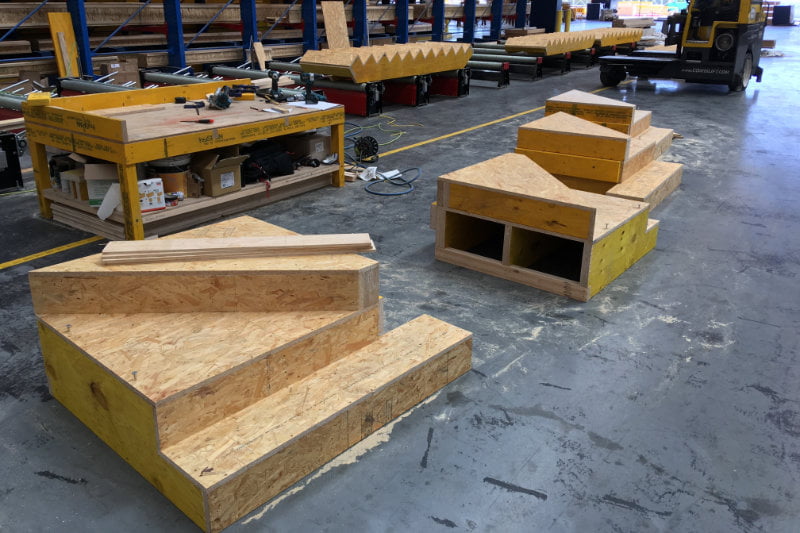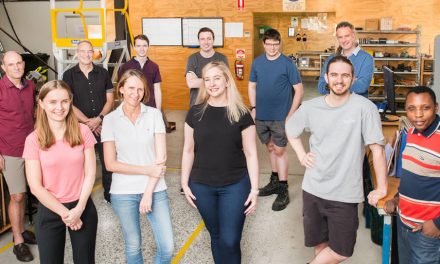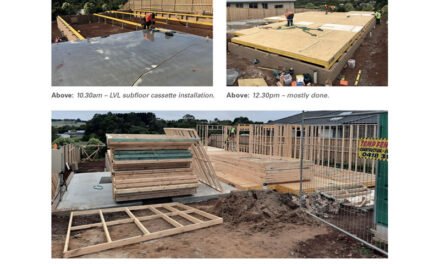Staircase cassettes go in fast, give following trades easy access, and can be fancied up to fit any style. Not bad for an idea dreamed up in a ski lodge.
Thomas Horsfall, project engineer at Meyer Timber, was on holiday in Jindabyne when he came up with the concept for the company’s staircase cassettes. “I was looking underneath the stairs in our lodge, digging out some snow gear, and I looked up and saw a staircase that was constructed from LVL and particleboard,” he says. “And I thought, ‘Oh, we’ve got a whole shed full of this. And a saw that can cut it!’”
Horsfall has been one of the driving forces in the company’s cassette offering and saw stairs as a natural addition to the existing floor and roof cassettes.
“We’re not talking about high-end, perfectly finished staircases,” he says. “The materials we use are generally LVL stringers with either OSB/4 or particleboard flooring over the top. They’re the same materials that you’d generally use for your structural floor system, because it is basically a floor system, with different geometry.”
As with the floor systems Meyer supplies, the raw finishes are tough and durable, ready for the workboots of tradies on site to stomp over them and able to cope with a large amount of wear and tear. Horsfall says, “And then you can cover it with carpet or strip flooring, or whatever your floor finishes are, once you get to the finishing stage. Or if you’re into the industrial look, sand it back to clean timber then add a polish/sealant. We’ve seen that in cafés and it adds a nice bit of texture.”
Cassettes that cover all the basic stair geometry are available. “A straight run would be one module,” says Horsfall, “whereas if you’ve got some winders and landings, you might end up with two to four modules in your stair structure. It doesn’t even need to be a timber-framed building, they slot just as well into a steel frame.”
Even better, they don’t add complexity to the logistics. “They fit well on trucks, in fact, they’re fairly compact compared to some of our other cassette offerings that can take up a lot of room or require some pretty big trucks,” Horsfall says. “And it’s easy to pack floor joists or other timbers needed for stick jobs around them, which makes the transport very economical.
“They work well in conjunction with a floor cassette, because you’ve already got the crane there on site. But there’s no reason why you can’t do them with a standard stick floor. A lot of the time there’ll be a small crane on site regardless, say, to lift up packs of flooring or to lift up packs of frames and that can drop the staircase in.”
But that’s not even the best part…
EASY ACCESS
The key advantage of stair cassettes is that they are in at a much earlier stage. “We can put stairs in at framing stage, as soon as the next floor is in,” Horsfall says.
“What that does is allows access for all the subsequent trades. All of the following jobs get much faster, because they’ve got much better access through the staircase rather than using a ladder to access the higher floor. So you save time on your staircase installation, but then that just compounds for the rest of the job.”
In terms of the time saved on the installation itself, a traditional stair install for a simple arrangement takes about a day on site. The stair cassettes, on the other hand, can be lifted into place and secured in about an hour for most jobs.
“Stairs are a pretty specialised area,” says Horsfall. “So being able to take that offsite and being able to order them as part of your standard frame and truss order is, I think, a real advantage for the builder.”
In addition to the time saved, site access becomes easier and ladder risk is removed. “Instead of trying to climb up and down ladders with buckets and sheets, they’re just walking up and down a staircase,” Horsfall says. “Obviously, that also has safety benefits for everyone on site.”
Because stairs are usually installed when more finishes are complete, the risk of rectifications being needed for, say, damaged plaster on nearby walls is also lessened.
Across the whole build, the benefits of the cassettes compound “I can’t put a precise figure on it,” says Horsfall, “because no one measures these things, but you can imagine the time savings multiplying every day as people just walk up a set of stairs rather than a ladder, and then at the end of the process, you give them a quick clean and are good to go with whatever the finish is, rather than having another install job left to do.
“The fact that we can deliver this at a competitive price, requiring no extra skills on site and no fancy equipment makes the stair cassettes really attractive.”
BUILDING THE MARKET
So far, the main market for the new product has been volume builders. “Typically, we’ve been selling the stair cassettes as an add-on to a floor cassette system,” says Horsfall. “It makes sense for them to expand that offsite buy where they can and make their work faster and easier on site.”
In some cases, Meyer is supplying all three of their cassette products: floor, stair and roof. “Not every build is set up for that,” Horsfall cautions. “There are some builds where the floor and stairs work fine as cassettes, but the roof makes more sense as trusses. Or maybe we’re doing the floor and roof but they want an architecturally designed staircase. It’s all about choosing what makes sense for the job.”
Helping builders to make that decision is the next challenge for the company.
It’s one thing to come up with a time- and cost-saving solution for the market, but another to get the information out to designers and convince builders to change their practices to incorporate it.
Meyer has been concentrating on the latter group, in part because they already have strong pre-existing relationships.
“Even for builders who haven’t used our other cassette products in the past, they’ll have used our design services and they’ll know that we’re all about making their lives easier and the end product better,” Horsfall says. “So when they come to us with a plan and we suggest stair cassettes, we’ll develop each specific design in conjunction with the builder, guiding them through it. They’ll work out whether it adds up for them in terms of cost and convenience.”
While most designs are fairly standard – situated between walls, perhaps a winder or two or a landing – there is a lot of design flexibility possible. Even the storage under the stairs that Horsfall originally saw in Jindabyne can be built in, “though we’d just do the basic stair structure for that, you’d need a joiner to do the shelving and doors,” he says. “But it makes sense as a storage solution, particularly in smaller houses.”
Having designers consider stair cassettes at the start of a project is the next step.
Horsfall says, “Generally, we’re not influencing architecture at the moment, we’re just taking standard architecture and adapting it to modular form. But we will start to get improved benefits when, right from early design stage, they’re thinking about prefabrication. It will help the builder finish jobs more quickly, get the best use out of limited timber supply and deliver a better flow of work to fabricators – both F&T companies and businesses like ours – which will produce more time and cost savings.”
Although this transition is still in its early stages, the advantages of cassettes have been well received by Meyer’s clients and this positive feedback is flowing up the design chain. Especially at a time when clients are concerned about the deliverability and expense of their builds, shifting to products like the stair cassettes will help keep some designs affordable and achievable.
“We’re already starting to see that shift,” says Horsfall. “ We’re starting to have a bit more influence on architects. And that will just grow as they see the way that we can optimise their construction.”
Horsfall doesn’t think he’ll be coming up with another product on his next holiday. “We’re starting to get to the limit of what we could do,” he says. “Our philosophy here is complementing the frame and truss market. Unless we get into walls… but there are a lot of people who already do them well.
For more, visit www.meyertimber.com.au












